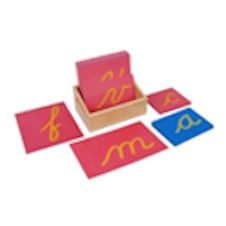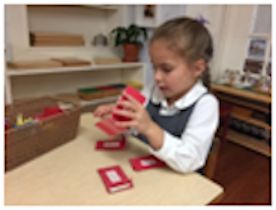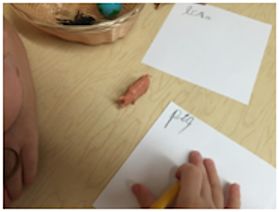Why do we teach cursive vs. print in Montessori?
by Hedy Lane
To write means to transcribe words, ideas or thoughts. Writing also involves rereading and editing such transcriptions to facilitate understanding. In the Montessori primary classroom, where children are between ages 3 and 6, we present writing before reading.
Why, you might ask.
?? Well, reading is a more complete process; a writer must break down words, sound by sound and then reconstruct the sounds to create words, and then, an image or thought. Learning to write involves the identification of sounds and composing a word.
Composition is purely cognitive work; recording is physical work. In terms of development, the child's mind is ready to compose before the hand is ready to write. In class, we have materials to aid in this process. One of them is the famous moveable alphabet:
(and, yes, it is in cursive!)
Now, let's take a quick journey; your child enters the primary class at age 3. Their introduction to language will be tracing the sand paper letters (our sand paper letters are cursive as well-and the benefits of cursive will be discussed later on).
While the student traces the letters over and over, the sound is repeated. This work employs their muscle memory, storing the information of both the shape and sound of the letter.
Once all 26 sounds are memorized, the student uses the moveable alphabet to "write" their thoughts, stories or lists of favorite words.
Phonograms are then introduced. This exposure broadens their vocabulary and the number of words they can write increases as their hand catches up with their mind. The muscle memory first created with the sandpaper letters asserts itself naturally and their writing occurs spontaneously!

First, there is much less confusions between the cursive forms of the letters, "b", "d", "p", and "q". This certainly helps with reversals and dyslexia.
Second, cursive is a more natural way of writing since the pencil flows along the paper without frequent stopping between the letters comprising the words. The circular movements natural to cursive also correspond developmentally to the stages of a young child's artwork.
Third, a child who can read cursive can also read print. The reverse, however, is not true.
Further, when printing, it is easy for a beginner to mix lower and upper case letters. Cursive prevents this confusion.
Finally, in the primary classroom, the students associate sounds with letters. This differs from a traditional classroom, where the names of the letters are associated with the letter itself.

Cursive writing is employed by everyone throughout their life. To increase proficiency with this tool of communication, early introduction is very important, when the child's interest in writing is at its greatest.
